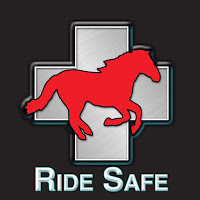Horse Safety Around the Barn Recap
Good morning!
Encouraging young ones to ride early in life can be such a blessing and adventure! However as we all know horses, especially for smaller kids, can pose an even bigger safety threat. That's why it's so important to educate our young riders on not only riding safety but equine etiquette and safety around the barn, pastures, trailers, etc. Thanks to this informative article from equisearch.com here is a good recap of a few safety measures all of us should practice when dealing with horses!
-Always speak to a horse to alert him of your presence before walking near; this avoids provoking his startle reflex.
-Approach from the side, to avoid his "blind" spots (directly in front of and behind him).
-Touch him first on the neck or shoulder, with a firm but gentle stroking motion.
-Always use a lead rope attached to the horse's halter, rather than grasping the halter itself, which provides no options if the horse were to startle.
-Don't coil the end of the lead rope around your hand, where the loops could tighten; instead, fold it back and forth and grasp the middle of the folds.
-Don't allow the horse you're leading to touch noses with an unfamiliar horse, as this can lead the "strangers" to suddenly bite or strike at one another. (This applies when you're mounted, as well.)
-Tie a horse "eye high and no longer than your arm," meaning the tie knot should be at least as high as the horse's eye, and the distance from the knot to the halter should be no more than the length of your arm.
-Tie only to a safe, solid object, using a quick-release knot or breakaway string (your child's instructor will explain how).
-Keep your fingers out of the loops as you tie the knot.
-Stand near the shoulder or next to the hindquarters rather than directly in front of or directly behind a horse when grooming his head or brushing or braiding his tail.
-To walk behind a horse, go either (1) close enough to brush against him (where a kick would have no real force), keeping one hand on his rump as you pass around; or (2) far enough away to be well out of kicking range.
For more safety tips visit the original article link here! To learn why kids should also have their own Ride Safe medical ID bracelets when riding or around the barn, visit www.teamridesafe.com!
Encouraging young ones to ride early in life can be such a blessing and adventure! However as we all know horses, especially for smaller kids, can pose an even bigger safety threat. That's why it's so important to educate our young riders on not only riding safety but equine etiquette and safety around the barn, pastures, trailers, etc. Thanks to this informative article from equisearch.com here is a good recap of a few safety measures all of us should practice when dealing with horses!
-Always speak to a horse to alert him of your presence before walking near; this avoids provoking his startle reflex.
-Approach from the side, to avoid his "blind" spots (directly in front of and behind him).
-Touch him first on the neck or shoulder, with a firm but gentle stroking motion.
-Always use a lead rope attached to the horse's halter, rather than grasping the halter itself, which provides no options if the horse were to startle.
-Don't coil the end of the lead rope around your hand, where the loops could tighten; instead, fold it back and forth and grasp the middle of the folds.
-Don't allow the horse you're leading to touch noses with an unfamiliar horse, as this can lead the "strangers" to suddenly bite or strike at one another. (This applies when you're mounted, as well.)
-Tie a horse "eye high and no longer than your arm," meaning the tie knot should be at least as high as the horse's eye, and the distance from the knot to the halter should be no more than the length of your arm.
-Tie only to a safe, solid object, using a quick-release knot or breakaway string (your child's instructor will explain how).
-Keep your fingers out of the loops as you tie the knot.
-Stand near the shoulder or next to the hindquarters rather than directly in front of or directly behind a horse when grooming his head or brushing or braiding his tail.
-To walk behind a horse, go either (1) close enough to brush against him (where a kick would have no real force), keeping one hand on his rump as you pass around; or (2) far enough away to be well out of kicking range.
For more safety tips visit the original article link here! To learn why kids should also have their own Ride Safe medical ID bracelets when riding or around the barn, visit www.teamridesafe.com!




Comments
Post a Comment